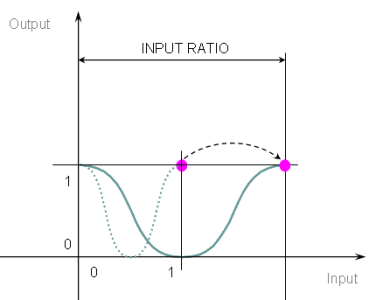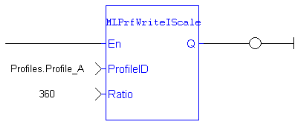MLPrfWriteIScale
![]()
 Function
Function![]() A function calculates a result according to the current value of its inputs.
A function has no internal data and is not linked to declared instances. - Sets the Input Ratio value of a selected CAM Profile
A function calculates a result according to the current value of its inputs.
A function has no internal data and is not linked to declared instances. - Sets the Input Ratio value of a selected CAM Profile![]() The position of a slave axis is mathematically linked to the position of a master axis.
Example: A system where two rotating drums turn at a given ratio to each other.
A more advanced case of electronic gearing is electronic camming.
With electronic camming, a slave axis follows a profile that is a function of the master position.
This profile need not be linear but it must be a mathematical function..
The position of a slave axis is mathematically linked to the position of a master axis.
Example: A system where two rotating drums turn at a given ratio to each other.
A more advanced case of electronic gearing is electronic camming.
With electronic camming, a slave axis follows a profile that is a function of the master position.
This profile need not be linear but it must be a mathematical function..
Inputs
|
Input |
Data Type |
Range |
Unit |
Default |
Description |
|---|---|---|---|---|---|
|
ProfileID |
DINT |
-2147483648 to 2147483647 |
N/A |
No default |
ID number of an initialized CAM Profile. |
|
Ratio |
LREAL |
N/A |
No default |
Desired new value of Input Ratio. |
Outputs
|
Output |
Data Type |
Range |
Unit |
Description |
|---|---|---|---|---|
|
Default (.Q) |
BOOL |
|
|
Returns TRUE if the Input Ratio is changed to the new value. |
Remarks
- Previous function name: MLPrfSetIRatio
- Ratios can be changed on the fly to modify the CAM Profile while maintaining its basic shape.
- A change in input ratio is equivalent to stretching the CAM Profile on the X (or Input) Axis.
Figure 1: MLPrfWriteIScale
FBD Language Example
FFLD Language Example
IL Language Example
Not available.
ST Language Example
//Change value of input ratio
MLPrfWriteIScale( Profiles.Profile_A, 360 );
See Also









